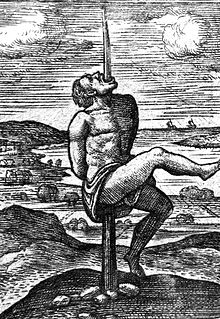
Impalement, as a method of torture and execution, is the penetration of a human by an object such as a stake, pole, spear, or hook, often by the complete or partial perforation of the torso. It was particularly used in response to "crimes against the state" and is regarded across a number of cultures as a very harsh form of capital punishment and recorded in myth and art. Impalement was also used during times of war to suppress rebellions, punish traitors or collaborators, and punish breaches of military discipline.
Offences where impalement was occasionally employed included contempt for the state's responsibility for safe roads and trade routes by committing highway robbery or grave robbery, violating state policies or monopolies, or subverting standards for trade. Offenders have also been impaled for a variety of cultural, sexual, and religious reasons.
References to impalement in Babylonia and the Neo-Assyrian Empire are found as early as the 18th century BC.